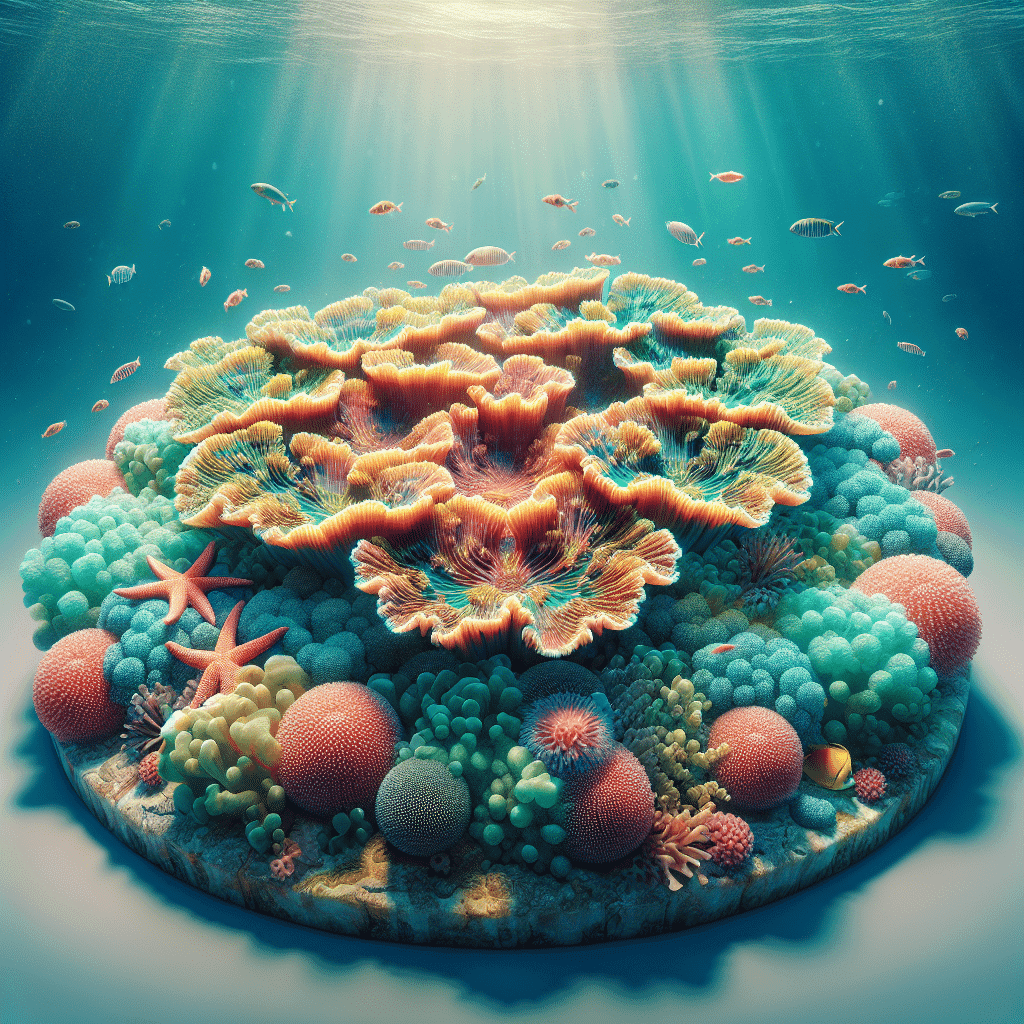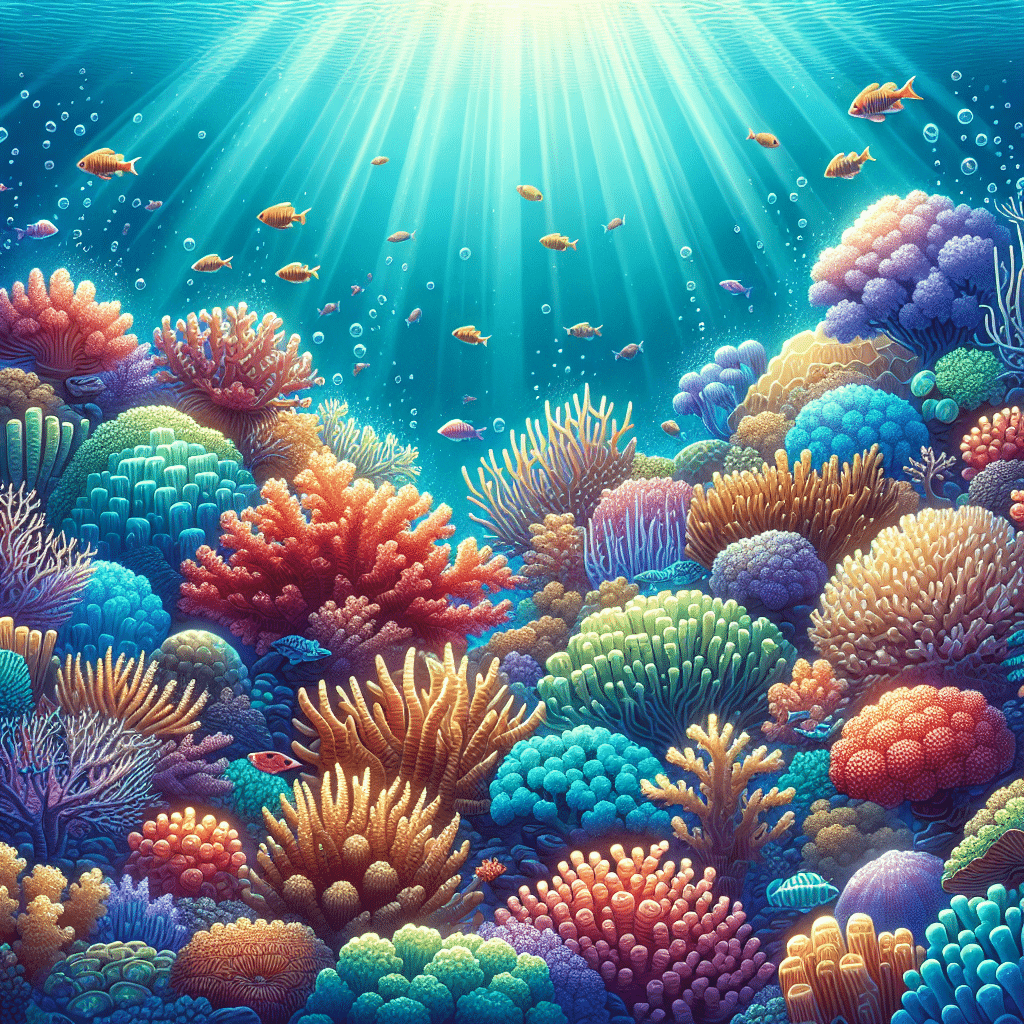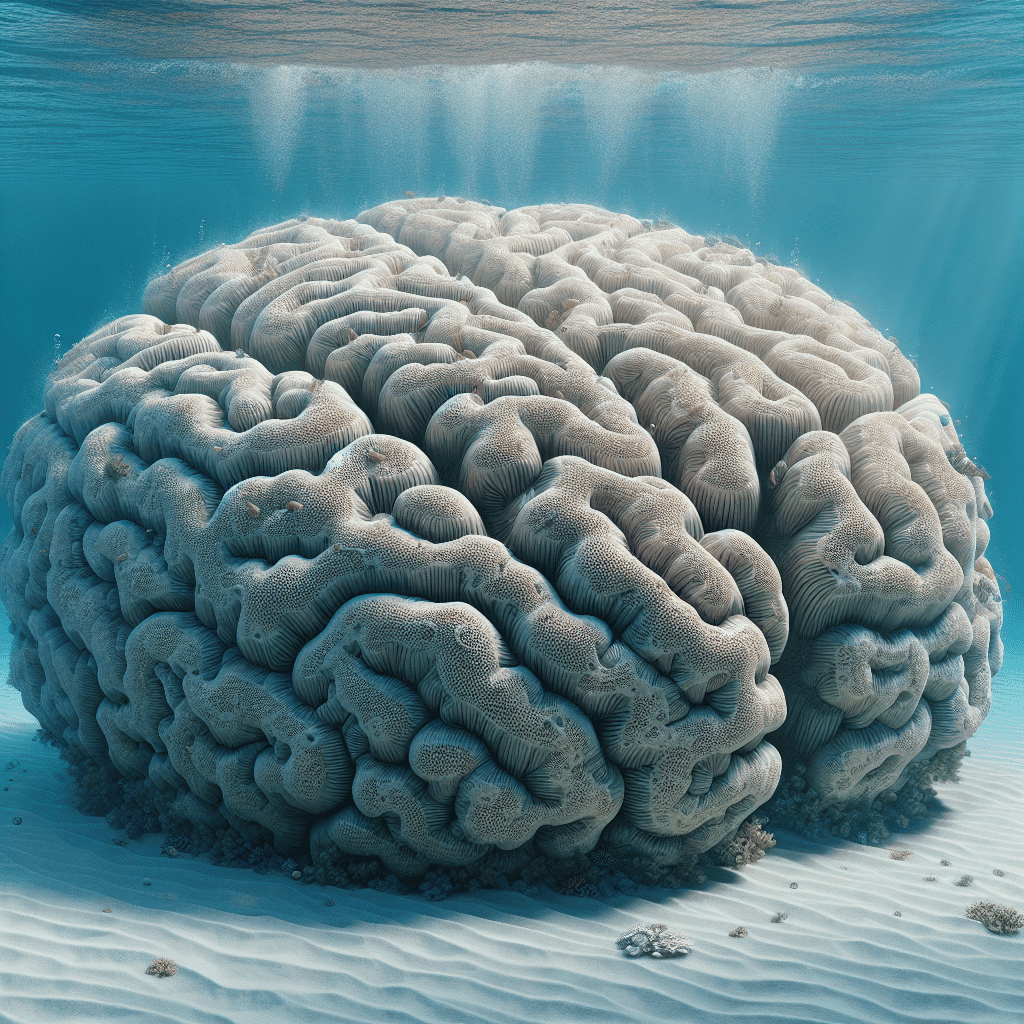Exploring Table Corals
As I dive into the world of reef tanks, one of the most fascinating types of corals I encounter is the table coral. These corals are not only beautiful but also play a significant role in the ecosystem of my aquarium.
Characteristics of Table Corals
Table corals are unique for their broad horizontal surfaces, which significantly increase the exposed area to the water column. This adaptation allows greater access to light for their symbiotic algae, known as zooxanthellae. The more light they receive, the better they can perform photosynthesis, which is crucial for their energy needs (NOAA).
| Characteristic | Description |
|---|---|
| Shape | Broad, flat surfaces resembling a table |
| Light Access | Maximizes exposure to sunlight |
| Feeding Mechanism | Uses tentacles to catch zooplankton |
| Symbiotic Relationship | Relies on zooxanthellae for energy |
Feeding Behavior of Table Corals
Feeding is another intriguing aspect of table corals. They primarily feed on zooplankton, which they capture using their tentacles. When I observe them in my reef tank, I notice how they extend their tentacles to catch tiny organisms floating by. This feeding behavior is essential, especially during the night when they are more active.
Table corals thrive in nutrient-rich waters, making them an excellent addition to a well-maintained reef tank. To support their feeding, I often supplement my aquarium with plankton or other coral food. This not only enhances their growth but also contributes to the overall health of my coral ecosystem.
For anyone interested in exploring more types of corals, I recommend checking out various species like staghorn coral or bubble coral, which also have unique characteristics and feeding behaviors.
Understanding Branching Corals
Branching corals are fascinating organisms that play an essential role in reef ecosystems. Their unique structure not only provides habitat for various marine life but also contributes to the health of the reef by maintaining water quality.
Sediment-Cleaning Abilities
One of the standout features of branching corals is their impressive ability to clean their surfaces of sediment. Compared to other coral morphologies, branching corals excel at removing deposited sediments, which is crucial for their health. When sediment settles on corals, it can block sunlight and hinder photosynthesis, leading to poor growth and potential bleaching.
Research shows that branching corals can reject siliciclastic sediment faster than carbonate sediment, making them particularly effective in environments with high sedimentation rates. Coarse silt is expelled more quickly than fine silt, especially at elevated deposition rates. While prolonged smothering by low organic content carbonate sediment can cause bleaching, it does not necessarily lead to mortality. This ability makes them resilient and adaptable in changing environments. For more insights into various coral types, check out our article on corals.
| Sediment Type | Rejection Speed |
|---|---|
| Siliciclastic | Fast |
| Carbonate | Slower |
| Coarse Silt | Faster at high rates |
| Fine Silt | Slower |
Impact of Flow Rates on Branching Corals
Flow rates significantly influence the sediment-cleaning abilities of branching corals. Higher flow rates enhance the corals’ ability to shed sediment and keep their surfaces clean. This is vital for their survival, as clean surfaces promote better health and growth.
In areas with low flow, sediments can accumulate, leading to adverse effects such as bleaching. Conversely, in regions with optimal flow conditions, branching corals thrive, showcasing vibrant colors and robust growth patterns. The interaction between flow rates and sedimentation is crucial for reef health, as it affects not only the corals themselves but also the diverse marine species that rely on these habitats.
Understanding these dynamics can help hobbyists create better environments in their reef tanks. For tips on maintaining a healthy reef tank, explore our articles on xenia and brain coral.
By recognizing the sediment-cleaning abilities and the importance of flow rates, I can better appreciate the role of branching corals in a reef ecosystem, whether it’s in a natural setting or in my fish tank.
Importance of Coral Reefs
Understanding the significance of coral reefs is essential for any reef tank enthusiast. These colorful underwater structures play a crucial role in maintaining marine biodiversity and supporting coastal communities.
Ecosystem Support
Coral reefs are critically important ecosystems that support a wide array of marine life. They provide habitat and shelter for numerous species of fish, invertebrates, and other marine organisms. This biodiversity not only sustains the health of the ocean but also supports coastal societies and economies throughout tropical regions.
The reefs act as natural barriers that protect coastlines from erosion and storm surges, which is vital for the safety of coastal communities. They also serve as a source of food and income for millions of people who rely on fishing and tourism activities related to healthy reefs. Unfortunately, the world has lost 30 to 50 percent of its coral reefs already, and without intervention, tropical reef ecosystems could face global extinction by the end of the century (NOAA Fisheries).
Threats to Coral Reefs
Despite their importance, coral reefs face numerous threats. Overfishing, pollution, and climate change are the primary culprits degrading these vital ecosystems. Climate change leads to rising sea temperatures, causing coral bleaching and making them more susceptible to diseases. Pollution from agricultural runoff and plastic waste can smother coral reefs, leading to a decline in their health and resilience.
Invasive species, such as the crown-of-thorns starfish, also pose a significant threat. Since 1962, outbreaks of this starfish have been a major source of coral loss, particularly in the Great Barrier Reef, where they have killed up to 90% of corals in affected areas (Australian Institute of Marine Science).
Efforts are underway to restore coral reefs through ecological restoration programs. NOAA facilitates various initiatives, including the establishment of over 20 coral nurseries in the Caribbean, which provide more than 40,000 healthy corals for restoration annually (NOAA Fisheries). Understanding these factors can help hobbyists like me contribute to the health and maintenance of our reef tanks and the larger marine environment.
For more insights on specific coral types, check out articles on brain coral, bubble coral, and staghorn coral to enrich your knowledge and care for your reef tank.
Coral Restoration Efforts
Coral restoration is a hot topic among reef tank hobbyists like me, especially when it comes to preserving our precious marine ecosystems. I often find myself wondering about the feasibility of these programs and the challenges faced in restoring corals, particularly table coral.
Feasibility of Restoration Programs
Some forms of coral rehabilitation can be feasible and affordable, especially in small areas that hold high economic value, like tourist hotspots. These efforts can work well in spaces less than 1 km², making them manageable and effective (One Earth). Organizations like NOAA are at the forefront of these efforts, running over 20 coral nurseries across the Caribbean, which produce more than 40,000 healthy corals each year for reef restoration (NOAA Fisheries).
However, while some small-scale restoration projects look promising, larger ambitions have proven elusive. If we are to see significant recovery in coral populations, broader changes must occur. This includes addressing climate change and reducing other human impacts on marine environments.
Challenges in Coral Restoration
Despite the potential for successful restoration, there are significant hurdles to overcome. One of the main issues is that coral restoration is likely to continue failing, even on a small scale, unless urgent action is taken to mitigate climate change and its impacts. Factors like rising sea temperatures, ocean acidification, and pollution are making it increasingly difficult for corals to thrive.
Another challenge is the logistics of maintaining coral nurseries and ensuring the health of the corals being grown. Even with dedicated efforts, the survival rate of transplanted corals can vary widely, influenced by environmental conditions and competition with other marine organisms.
In summary, while there are efforts being made to restore corals, including table coral, the road ahead is filled with challenges. For those of us with reef tanks, it’s essential to stay informed about these initiatives and how they may impact our hobby and the larger marine environment. Keeping our tanks healthy and thriving also contributes to the overall health of coral populations in the wild.
Economic Value of Corals
Global Economic Contribution
Corals are incredibly valuable to our economy, contributing about $10 trillion each year globally. Domestically, they add over $3 billion annually. This economic value comes from various sources, including tourism, fishing, and coastal protection. Hundreds of millions of people depend on coral reefs for their livelihoods, food, and cultural practices. The health of these ecosystems is crucial not just for marine life but also for human communities relying on their resources.
| Contribution Type | Economic Value |
|---|---|
| Global Contribution | $10 trillion/year |
| Domestic Contribution | $3 billion/year |
The benefits of coral reefs extend beyond just financial aspects; they also provide essential ecosystem services, such as protecting coastlines from erosion and supporting biodiversity.
Dependence on Coral Reefs
The dependency on coral reefs is evident in many coastal societies. They provide food through fish and shellfish, which are vital for local diets and economies. Additionally, coral reefs are a significant draw for tourism, attracting divers and snorkelers from around the world. This tourism generates significant revenue for local businesses and creates jobs in hospitality and recreation.
| Dependency Aspect | Description |
|---|---|
| Food Sources | Fish and shellfish for local consumption |
| Tourism | Revenue from diving and snorkeling activities |
| Coastal Protection | Natural barrier against storms and erosion |
However, with the alarming degradation of coral reefs due to overfishing, pollution, and climate change, the future of these economic benefits is at risk. If current trends continue, we could see a drastic decline in coral reef health, impacting those who rely on them. For more insights on coral species and care, check out articles on staghorn coral, bubble coral, and brain coral.
Coral Conservation Initiatives
As a reef tank hobbyist, I’ve learned that coral conservation is crucial to maintaining the beauty and health of our underwater ecosystems. Two significant initiatives that stand out are NOAA’s Coral Nurseries and the Mission: Iconic Reefs Project. Both efforts aim to restore and protect coral populations, which are vital for marine life.
NOAA’s Coral Nurseries
NOAA plays a pivotal role in coral conservation through its coral nurseries. They facilitate, lead, fund, and implement efforts to grow corals in protected conditions. Over 20 coral nurseries are active throughout the Caribbean, providing more than 40,000 healthy corals for reef restoration annually (NOAA Fisheries). This not only helps to replenish coral populations but also supports the overall health of reef ecosystems.
| Coral Nursery Location | Number of Corals Produced Annually |
|---|---|
| Caribbean | 40,000+ |
These nurseries allow hobbyists like me to have access to healthy corals, which can be used to enhance personal reef tanks. By supporting these conservation efforts, we contribute to the sustainability of coral reefs.
Mission: Iconic Reefs Project
In addition to the nurseries, NOAA and its partners are working on the Mission: Iconic Reefs Project. This ambitious project aims to restore coral cover across seven sites in the Florida Keys National Marine Sanctuary. The goal is to increase coral coverage from a mere 2 percent to an average of 25 percent (NOAA Fisheries).
This project is vital because the world has already lost 30 to 50 percent of its coral reefs. Without significant intervention, tropical reef ecosystems could face global extinction by the end of the century (NOAA Fisheries).
As someone invested in reef tanks, I find it encouraging to see such initiatives underway. The restoration of coral reefs supports not only marine biodiversity but also enhances the beauty of our underwater environments. By participating in discussions around these projects and advocating for coral conservation, I can play a part in ensuring that future generations will be able to enjoy vibrant coral reefs.
Coral Species Spotlight
As a reef tank hobbyist, I’ve always found it fascinating to learn about different coral species and their unique characteristics. Here are some of my favorites that you might consider for your own tank.
Staghorn Coral
Staghorn coral, known for its rapid growth, plays a crucial role in coral reef ecosystems. It helps establish reefs and provides habitat for various marine life. Unfortunately, it faces significant threats from coral bleaching due to global warming. If you’re considering adding staghorn coral to your reef tank, make sure to maintain optimal water quality and lighting to support its growth. For more details on this coral, check out staghorn coral.
| Feature | Description |
|---|---|
| Growth Rate | Fast |
| Main Threats | Coral bleaching, global warming |
Elkhorn Coral
Elkhorn coral has a unique antler-like shape and was once abundant in Caribbean reefs. Sadly, it is now critically endangered, mainly due to global warming and coral bleaching. If you have a tank setup that mimics its natural habitat, it could thrive, but be prepared for careful maintenance. More information can be found on elkhorn coral.
| Feature | Description |
|---|---|
| Shape | Antler-like |
| Status | Critically endangered |
Carnation Coral
Also known as “Dendronephthya,” carnation coral is a vibrant species found in the Red Sea and Indian Ocean. It thrives in strong currents and showcases stunning colors like pink, red, orange, and yellow. If you’re looking for a show-stopping coral, this might be the one for you! Learn more about it on carnation coral.
| Feature | Description |
|---|---|
| Habitat | Strong currents |
| Colors | Pink, red, orange, yellow |
Bubble Coral
Bubble coral, or Plerogyra sinuosa, is commonly found in sheltered areas and reaches depths of 3-35 meters. Its polyps resemble bubbles during the day and extend at night to hunt for food. This makes it a visually appealing addition to any reef tank. For more on this species, check bubble coral.
| Feature | Description |
|---|---|
| Depth Range | 3-35 meters |
| Appearance | Bubble-like polyps |
Grooved Brain Coral
Grooved brain coral, scientifically known as Diploria labyrinthiformis, is characterized by its large structure. It grows slowly, with some corals being hundreds of years old. The living tissue is only a few millimeters thick, so it’s vital to provide a stable environment in your reef tank. Discover more about this coral on brain coral.
| Feature | Description |
|---|---|
| Growth Rate | Slow |
| Age | Can be hundreds of years old |
These corals not only add beauty to a reef tank but also play a significant role in the ecosystem. When selecting corals, consider their care requirements, placement, and compatibility with other species in your tank. Happy reefing!
Threat from Crown-of-Thorns Starfish
Crown-of-thorns starfish (COTS) pose a significant threat to coral reefs, particularly in places like the Great Barrier Reef. Understanding their impact and behavior is crucial for reef tank hobbyists like me.
Impact on Coral Reefs
Crown-of-thorns starfish are notorious for causing extensive loss of reef-building corals. One adult starfish can consume up to 10 square meters of coral in a year. They tend to favor fast-growing corals, such as branching corals and plate corals belonging to the genus Acropora (Australian Institute of Marine Science). Since 1962, outbreaks of these starfish have been a leading cause of coral loss on the Great Barrier Reef, with recent events killing up to 90% of corals on affected reefs.
| Year of Outbreak | Estimated Coral Loss (%) |
|---|---|
| 1962 | High |
| 1980s | Moderate |
| 2000s | Severe |
| 2020s | Up to 90% |
It’s vital for reef tank owners to monitor any signs of COTS in their aquariums, as these starfish can devastate coral health and biodiversity.
Reproductive Behavior and Toxicity
Crown-of-thorns starfish are prolific breeders. A large female can release over 200 million eggs annually. The larvae drift as plankton for 10 to 30 days before transforming into a small starfish form with five arms (Australian Institute of Marine Science).
These starfish are also equipped with sharp spines that can inflict pain on any creature that comes into contact with them. They release toxins capable of causing liver damage and destroying red blood cells, posing a risk to both marine life and humans.
As a reef tank hobbyist, it’s essential to stay informed about the challenges posed by crown-of-thorns starfish and consider preventive measures to protect corals in my aquarium. Regular checks and maintenance can help ensure a healthy environment for my corals, such as table coral and other species.



